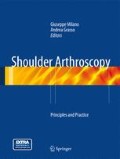Abstract
Arthroscopy has made it possible to define many of the known lesions related to shoulder disorders and to identify other, new ones. The surgeon must be familiar with these different lesions and with their surgical treatment. Although careful planning of an appropriate therapeutic procedure on the basis of clinical and instrumental examinations is crucial, the surgeon, faced with the arthroscopic diagnosis, is often required to use different techniques from those initially planned. In shoulder arthroscopy, the ideal setup is therefore one that is versatile enough to allow the execution of different surgical procedures. Achievement of this objective depends on careful planning and preparation of the instrumentation. The surgical team, the anesthesiologist, and the operating room staff all play a part in setting up the operating room: only through teamwork is it possible to ensure optimization of complex and versatile surgical procedures.
Access this chapter
Tax calculation will be finalised at checkout
Purchases are for personal use only
References
Gross RM, Fitzgibbons TC. Shoulder arthroscopy: a modified approach. Arthroscopy. 1985;1:156–9.
Cooper DE, Jenkins RS, Bready L, Rockwood Jr CA. The prevention of injuries of the brachial plexus secondary to malposition of the patient during surgery. Clin Orthop Relat Res. 1988;228:33–41.
Andrews JR, Carson Jr WG, Ortega K. Arthroscopy of the shoulder: technique and normal anatomy. Am J Sports Med. 1984;12:1–7.
Matthews LS, Fadale PD. Technique and instrumentation for shoulder arthroscopy. Instr Course Lect. 1989;38:169–76.
Park TS, Kim YS. Neuropraxia of the cutaneous nerve of the cervical plexus after shoulder arthroscopy. Arthroscopy. 2005;21:631.
Pavlik A, Ang KC, Bell SN. Contralateral brachial plexus neuropathy after arthroscopic shoulder surgery. Arthroscopy. 2002;18:658–9.
Skyhar MJ, Altchek DW, Warren RF, Wickiewicz TL, O’Brien S. Shoulder arthroscopy with the patient in the beach-chair position. Arthroscopy. 1988;4:256–9.
Mullins RC, Drez Jr D, Cooper J. Hypoglossal nerve palsy after arthroscopy of the shoulder and open operation with the patient in the beach-chair position. A case report. J Bone Joint Surg. 1992;74A:137–9.
Klein AH, France JC, Mutschler TA, Fu FH. Measurement of brachial plexus strain in arthroscopy of the shoulder. Arthroscopy. 1987;3:45–52.
Author information
Authors and Affiliations
Corresponding author
Editor information
Editors and Affiliations
Rights and permissions
Copyright information
© 2014 Springer-Verlag London
About this chapter
Cite this chapter
Salvatore, M., Latte, C., Grasso, A. (2014). Operating Room Setup and Patient Positioning. In: Milano, G., Grasso, A. (eds) Shoulder Arthroscopy. Springer, London. https://doi.org/10.1007/978-1-4471-5427-3_8
Download citation
DOI: https://doi.org/10.1007/978-1-4471-5427-3_8
Published:
Publisher Name: Springer, London
Print ISBN: 978-1-4471-5426-6
Online ISBN: 978-1-4471-5427-3
eBook Packages: MedicineMedicine (R0)

